I got to dyeing in a roundabout way. I am a lifelong quilter and I began dyeing my own fabrics to use in my quilts. From there, I expanded into dyeing: dyeing yards to use in weaving, batik dyeing and finally a curiosity about dyes themselves.
Except for Lima, which sits at sea level, Peru is a high country, sprawling across the Andes. Macchu Picchu, which is probably the most famous place in Peru, is above 8000 feet. But it is nothing compared to Cusco, which is about 11,000 feet. The land is arid and the ancient peoples including the Incans were brilliant at utilizing the scant water to irrigate their crops. Potatoes come from Peru and this country has several thousand varieties, although not all are edible.
Peru is a goldmine for anyone interested in dyeing. In previous blogs, I’ve talked about the cochineal beetle, which is native to Peru. Properly mordanted, the blood of these beetles creates a vivid red.
Darker burgundy comes from another berry, green from the chilka leaf and shades of brown, black and white from the hair of the alpaca and the llama. ( The vicuna also provides wool of an extremely fine quality but this animal has never been domesticated. The Incans spent much time selectively breeding alpacas to obtain an extremely fine fleece but once their Empire ended that breeding program ended. In some of the museums in Peru examples of these old textiles can be viewed. )
The weavers also use indigo for blue. Indigo is not native so it is more expensive.
 It is truly amazing to watch the weavers using the backstrap loom.
It is truly amazing to watch the weavers using the backstrap loom.

